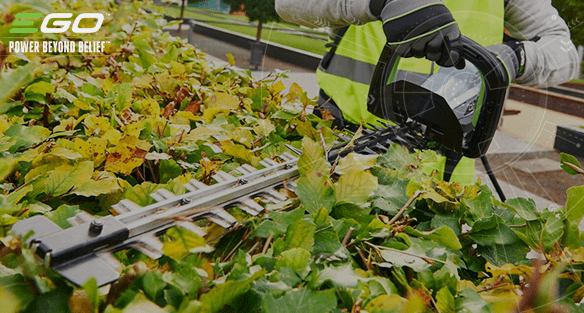Some gardeners have a good eye for a straight line, but if you want to be certain of getting the result you imagined, you need a guide.
Formal or informal hedge?
A formal hedge is one with clean lines and geometric angles and curves. It can be cut straight up and down or wider at the top to allow light to permeate the lower area.
An informal hedge is where the gardener has worked to retain a natural-looking shape while keeping it tidy and healthy.
How to cut a formal hedge
Your tools
- Bamboo canes or similar
- String
- Battery-powered hedge trimmer
- Secateurs
The method
- Stake your bamboo canes firmly along a long side of the hedge.
- You need to create the cutting guide for the top of the edge first. Do this by tying the string at the height you want to cut down to. Don’t over-stretch the string or the canes.
- Make sweeping, gentle cuts away from yourself, across the top of the hedge, until it’s level with your guide. Don’t over-reach. Get someone to foot your ladder if you’re using one. Or better yet, make the most of our cordless multi-tool, and attach extension pole and hedge trimmer attachment.
- Remove the cuttings so they don’t create a fungal problem.
- Next, move your string guides above the top level of the hedge to create the guide for the sides. You might also have to move your canes in a little.
- Make shallow, sweeping cuts to the hedge sides from bottom to top.
- Reach into the body of the hedge and, using the secateurs, remove some branch density to allow light and air in.
How to prune an informal hedge
Your tools
- Secateurs, shears, or a battery-powered pole saw
The method
- Remove dead, broken, diseased or problem branches first. Ensure you cut them at the point of origin, or if not possible, as close to the strongest shoot as you can.
- Move onto the older, longer branches if you want to cut it back further.
- Prune all sides and the top for a natural look that doesn’t seem lop-sided.
- Remove cuttings so they don’t create a fungal problem.
More considerations when trimming a hedge
1. Evergreen or deciduous?
Different types of hedge plant require different treatment at different times of the year. Some species, for example, like to be trimmed back in spring; others prefer winter.
Evergreens shouldn’t be trimmed back hard, as they might develop care patches that it’s tricky (often impossible) to fix. On the other hand, deciduous shrubs are more easy-going about when they are pruned.
2. Care of birds
In EU and UK law, it’s forbidden to intentionally kill, catch or disturb native birds. It’s also against the law to destroy their breeding, feeding and roosting habitats - this includes nests made in hedges.
Wait until the birds have fledged. Be cautious - even after the summer, some species may be building nests for new families.
3. Health and safety
Read your manual for safe operation of your hedge trimmer and always wear appropriate PPE, including safety glasses.
Hedge trimming isn’t difficult or demanding, but the weight and ergonomic nature of your tool will influence the end result.
EGO battery-powered hedge trimmers are light, ergonomic and durable. They are also quieter, give off less vibration and have no emissions.
In addition, our range includes hedge trimmers with cutting lengths between 51cm to 75cm - one to suit every hedge!
